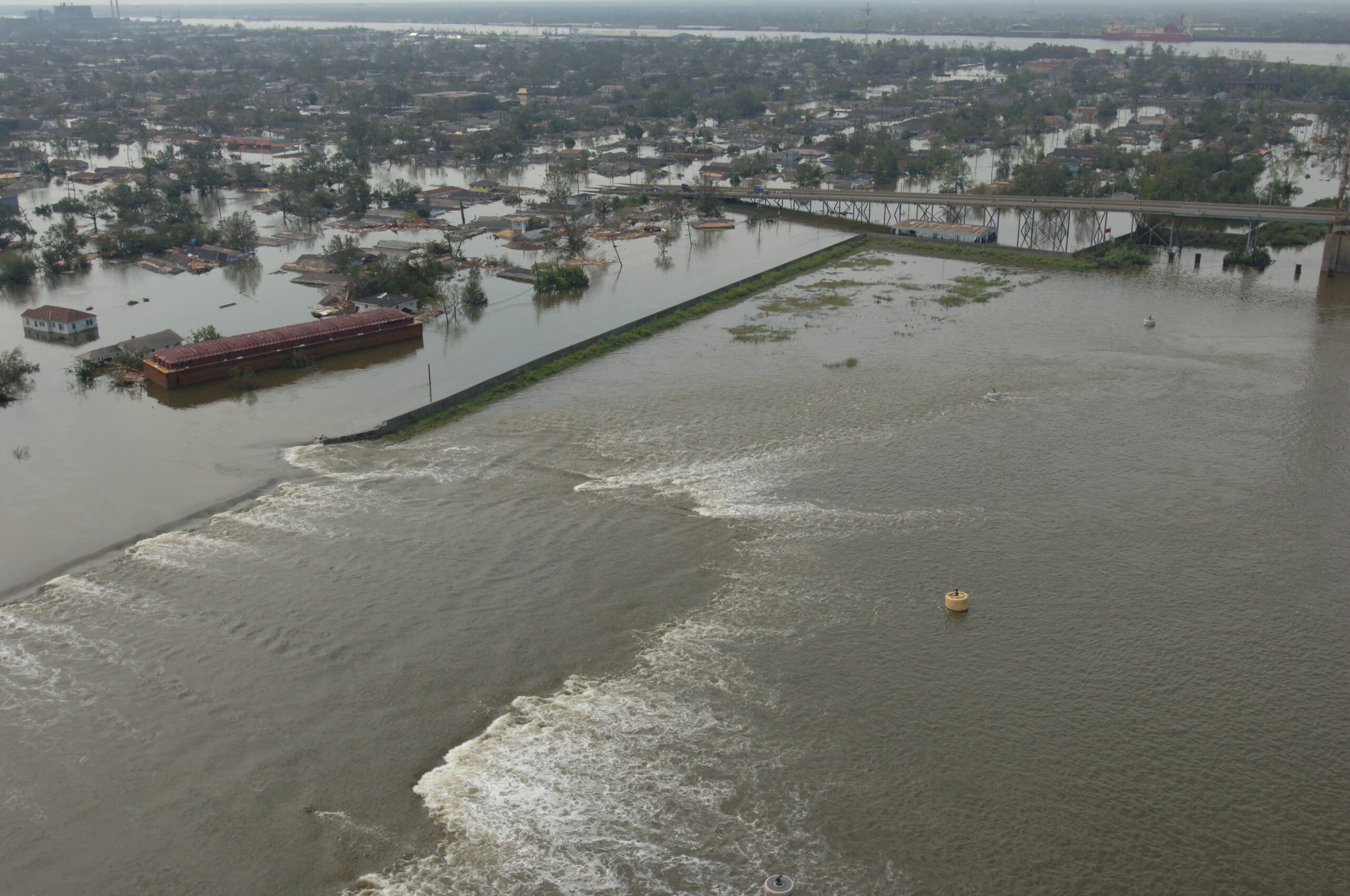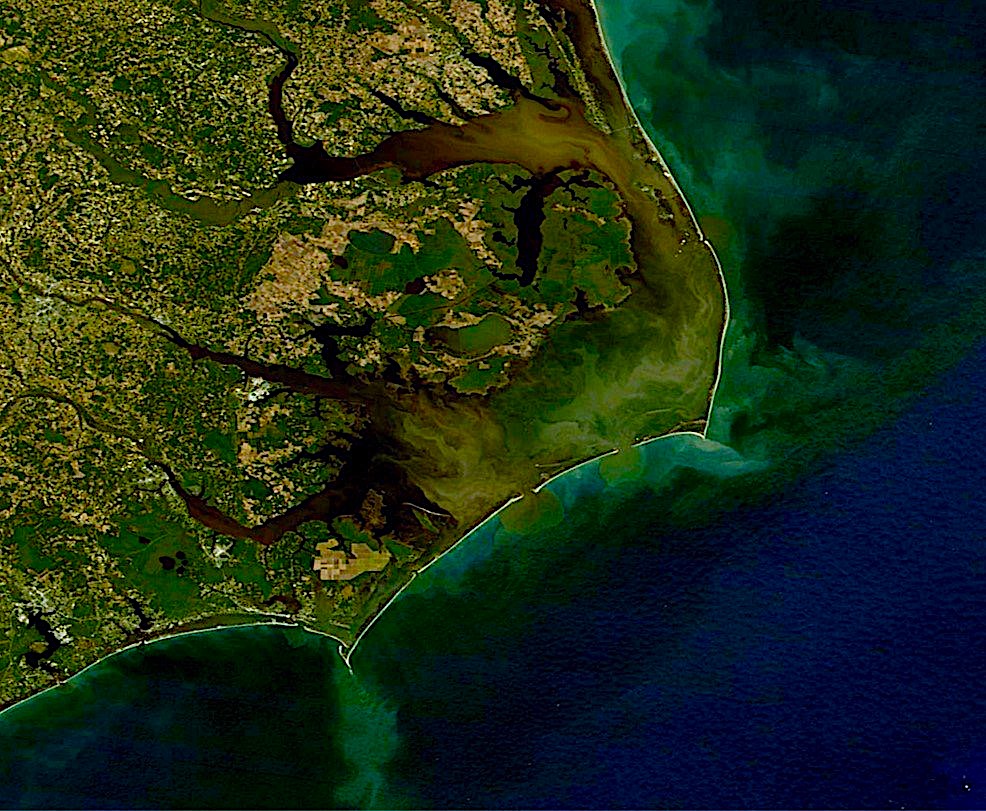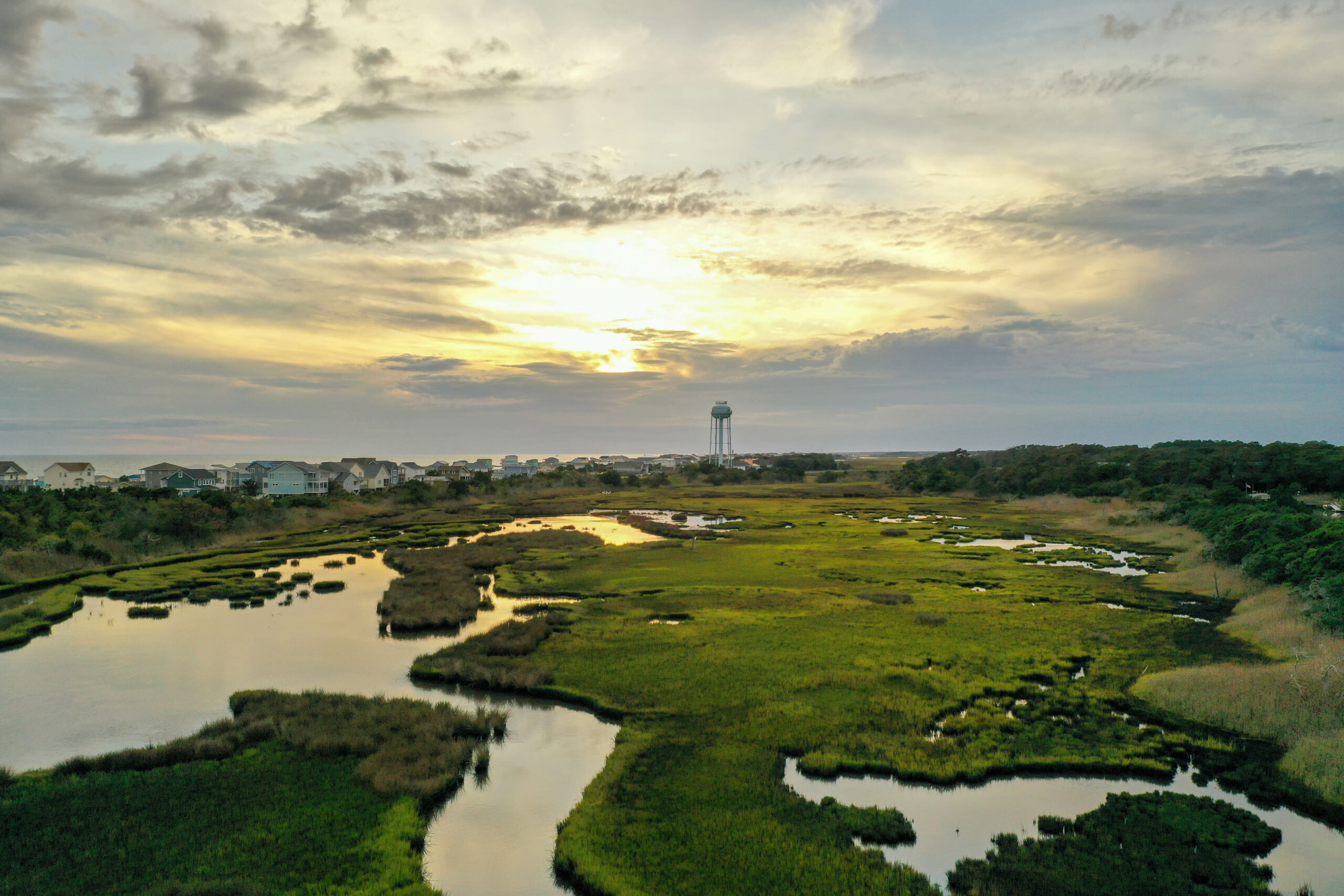STORM SURGE: Lessons from Katrina

Weeks after Hurricane Katrina, miles and miles of remains from homes and buildings were scattered along Mississippi’s Gulf Coast.
“The debris field was so heavy behind the beach road that it diminished the waves,” says Spencer Rogers, who conducted a survey on flood damage.
Extremely high water marks are another legacy from the massive storm that struck the shorelines of Mississippi, Louisiana and Alabama on Aug. 29, 2005.
“One school in Pass Christian had water marks more than 25 feet above sea level,” says Rogers, North Carolina Sea Grant’s coastal construction and erosion specialist. “Katrina caused the highest surge recorded in the United States — way above the 24.3-foot storm surge from Hurricane Camille that devastated the Gulf Coast in 1969.”
Rogers reviewed the storm’s flood damage as a member of the assessment team for the American Society for Civil Engineers (ASCE). He also was a consultant for the Federal Emergency Management Agency (FEMA) Mitigation Assessment Team (MAT) that included FEMA engineers and experts, as well as consultants from other governmental agencies and private industry.
A few weeks after the storm, Rogers began reviewing the structural damage from the storm surge, using a camera, tape measure and Global Positioning System to identify locations.
“Usually, we look at the damage, as well as those buildings that successfully avoided damage,” he says. “The storm was so bad and the flood maps were so out-of-date that we only found severely damaged buildings that were repairable.”
BUILDING DAMAGE
Rogers found only a few structures that survived the worst of the powerful storm surge and waves.
At one house, damage was only on the lower floor. “However, the upper part of the house survived because of a high foundation,” he says. “And, five rows behind this, every house was destroyed.”
“The key to preventing flood damage from hurricanes is to construct a building on an open-pile foundation that is above the wave height,” he adds. “Walls that get hit by breaking waves as small as 1.5 feet are usually severely damaged or destroyed.”
Rogers was amazed that he could ride down a highway near the beach.
“There was no erosion or sand buildup on Hwy. 90 in Pass Christian,” he says. “Usually, low-lying island beach roads are impassable after hurricanes because of sand buildup and erosion.”
Waves cause erosion and undermine the pavement, moving sand from the beach and burying the road, he explains. “The roads are often blocked by construction debris and floating buildings. In Mississippi, the roads were mostly clear, and the debris was pushed several thousand feet inland from the road and shoreline.”
Hurricane Katrina was one of the strongest storms to hit the coastal United States during the past 100 years. The catastrophic storm made landfall in Louisiana and Mississippi with only Category 3 winds but with a storm surge of a Category 5 hurricane.
The record surge caused widespread devastation in the coastal areas of Alabama, Louisiana and Mississippi, including Bay Saint Louis, Pass Christian and Long Beach. A few weeks after Katrina, Hurricane Rita damaged the western half of the Louisiana coastline all the way into Texas.
Although Katrina’s hurricane eye did not directly hit New Orleans, catastrophic destruction occurred throughout the southeast portion of Louisiana. On Aug. 29, three major levees broke. Two days later, at least 80 percent of New Orleans was flooded, according to the FEMA MAT report.
“Katrina significantly exceeded the base flood elevations by as much as 15 feet along parts of the Louisiana and Mississippi Gulf Coast,” the report says. Flooding exceeded well beyond the inland limits of the Special Flood Hazard Area, the floodplain affected by the base flood.
“As of Feb. 15, 2006, the number of flood insurance claims exceeded 210,000, covering Alabama, Louisiana, Mississippi, and Florida, with over 175,000 of these claims coming from Louisiana,” according to FEMA. In Alabama, 363 dwellings were destroyed compared to more than 68,000 in Mississippi and more than 283,000 in Louisiana.
Only federal flood insurance covers rising water. FEMA manages this supplementary insurance through the National Flood Insurance Program.
Wind damage also contributed to the destruction. Widespread wind damage to buildings occurred despite the fact that Katrina’s wind speeds were generally at or below the speeds for which wind codes are set, the FEMA report says.
BUILDING CODES
Prior to Katrina, Alabama, Louisiana and Mississippi did not have statewide codes for non-state-owned buildings, according to the FEMA report.
Many of the communities that were heavily impacted by Katrina did not have up-to-date building codes or had no codes at all. “The lack of adequate building codes greatly compounded the effect of Hurricane Katrina on building performance,” the report says.
The primary model building codes in the United States are the International Building Code (IBC) and the International Residential Code (IRC). The 2003 editions of the IBC and IRC address flood hazards.
In Alabama, the City of Mobile, Mobile County and the City of Orange Beach had adopted IBC codes before Katrina.
Since Katrina, Dauphin Island adopted the IBC requirements and recently adopted provisions requiring deeper pile embedment.
In addition, a number of jurisdictions in Mississippi have adopted the 2003 IBC codes. However, the state hasn’t adopted a code for buildings not owned by the state. A Governor’s Commission report, issued on Dec. 31, 2005, recommended adopting local building codes as a primary hazard mitigation strategy.
Louisiana Gov. Kathleen Blanco signed a new law last year after the storms, requiring enforcement of the 2003 IBC and IRC statewide.
No one knows how North Carolina would fare if a devastating storm like Katrina hit. However, the state has one of the oldest hurricane construction codes in the country, first implemented in the 1960s and improved over time. The most recent version is based on the International Code, with amendments addressing North Carolina’s needs.
Current building practices include an open-piling foundation for oceanfront properties, combined with a high first-floor elevation, so waves can pass through.
“There is a low probability that North Carolina will get a storm with the water level as high as it was during Katrina,” says Rogers.
Earlier this year, the N.C. Building Code Council implemented rules requiring storm shutters for windows and doors on all new homes built within 1,500 feet of the ocean, a much narrower zone than the national standard. The Council will reassess the width of the zone after several reports on Florida are released later this year.
Rogers has decades of experience studying buildings damaged by storms. During the last 31 years, he’s surveyed the structural damage from the storm surge and waves caused by most major hurricanes that have hit the East and Gulf coasts.
After Hurricane Hugo in 1989, Rogers initiated a research project that revealed walls designed to withstand 125-mph winds would fail after only a few 1.5-foot waves.
Rogers and colleagues from North Carolina State University and Oregon State University developed a simple and failsafe design for “breakaway walls” that would maintain a building’s structural integrity in both high wind and storm surge.
By 2005, ASCE had broadened the application of the Sea Grant research results to include building foundation design in “Coastal A-Zones,” areas where 1.5-foot breaking waves are expected during the predicted 100-year storm surge. The information is incorporated into ASCE’s updated national Flood Resistant Design and Construction Standard.
Following the devastation of Hurricane Katrina, FEMA — for the first time — delineated the l.5-foot wave zone in its Advisory Base Flood Elevation Maps for Mississippi.
Rogers also has collaborated with South Carolina Sea Grant, Clemson University and the Blue Sky Foundation on a new type of plywood shutters for homes.
STRUCTURAL ISSUES
To understand the massive storm surge and wave damage that occurred in Mississippi, Rogers looked at two critical issues: Why do high storm surges occur? Why are waves a threat to buildings?
To evaluate the flooding, he used a storm surge model, known as the “Sea, Lake and Overland Surges from Hurricane” or “SLOSH” and prepared by the National Ocean & Atmospheric Administration and the U.S. Army Corps of Engineers for coastal sections.
The model predicts the worst-case storm surge from an array of hurricane tracks for each hurricane category.
Rogers then combined the results of the study grids and plotted the peak water levels along the “first developed shoreline from Texas to Tampa Bay.”
“For most of the Mississippi coast, the storm surge for each hurricane category is roughly twice as high as is typical for other areas along the Gulf and Atlantic coast,” he says.
Although Katrina weakened to a Category 3 before making landfall, experts estimate the surge to have maintained a level associated with a Category 5 hurricane. The surge did not dissipate as rapidly as the wind speed, says Rogers.
“Katrina came into the Mississippi Gulf Coast on the worst possible track for a high storm surge,” he says. “The shallow depth of the offshore shelf in the Gulf of Mexico, as well as the bay-like shape of the shoreline, contributed to the high surge.”
“It is therefore no accident that Camille and Katrina set records in the same area,” Rogers adds. Another hot spot is the Big Bend area of Florida that stretches from Bayonet Point through Homosassa Springs and the Crystal River to Steinhatchee.
NEW REPORT
The FEMA MAT report makes numerous flood recommendations, including establishing flood levels in the building codes that exceed the current base-flood elevation.
The federal agency also encourages communities to review storm surge data and conduct a revised tide frequency analysis. For rebuilding efforts, it encourages local officials to use the Katrina Flood Recovery Maps until the new flood maps are released. The base-flood elevations were established to expedite the rebuilding process of hard-hit areas in Louisiana and Mississippi.
“Although FEMA cannot require communities to adopt the Advisory Flood Elevations, continued use of the flood data on the current Flood Insurance Rate Maps could result in residential and commercial buildings that will be vulnerable to flood damage,” the report says.
The buildings in Mississippi and Louisiana were not built high enough or do not have the structural integrity to resist flood forces that may be encountered in future large events.
To find out more about the FEMA MAT report on Hurricane Katrina, visit the Web: http://www.fema.gov/.
This article was published in the Autumn 2006 issue of Coastwatch.
For contact information and reprint requests, visit ncseagrant.ncsu.edu/coastwatch/contact/.
- Categories:


